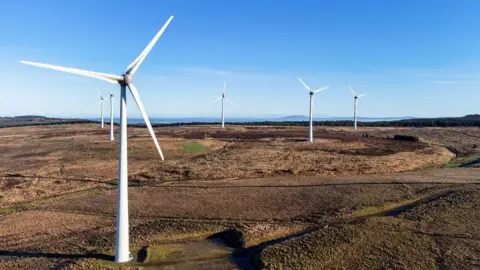'Clock is ticking' on NI meeting energy target
 Getty Images
Getty ImagesUnused and wasted renewable energy will cause Northern Ireland to miss its 2030 power emissions target by more than 20%, a consultancy firm says.
The forecast, from Cornwall Insight, says a reduction of around 50% is likely, rather than the 73% aim.
It adds that almost 40% of wind energy generated in Northern Ireland in December 2024 went unused due to restrictions in the power grid.
And it expects emissions to rise in the near term, due to increasing demand and the slow expansion of renewable generation.
'Operational reasons'
The Republic of Ireland is also expected to fall short of its 2030 target of 75%, although emissions there are expected to decline steadily.
The firm said increased investment in infrastructure and energy storage will be critical in meeting targets.
Lisa Foley from Cornwall Insight says further delays with the north-south interconnector will have an impact on energy emissions in Northern Ireland.
"There are operational reasons why the system operators may need to run more gas in Northern Ireland rather than renewables in Ireland that could be utilised but are limited by flows on the existing infrastructure, and delays to the north-south interconnector will exacerbate that," she said.
"There is the standard level demand increase around population growth, manufacturing, requiring more demand."
Ms Foley says demand "isn't being met by renewables", therefore "it needs to be met by gas and imports on the interconnectors" and Northern Ireland needs to "catch up" to meet demand.
Wind is a fluctuating energy source, so limits on how much can be used are imposed on the power grid in both jurisdictions.
'Serious investment'
Under a process called dispatch down, transmission system operators can instruct renewable generators to reduce or entirely switch off output.
That's to ensure the whole system stays at a steady frequency and that the electricity infrastructure is managed.
The dispatch down rate in Northern Ireland in December 2024 (38.4%) was more than three times the level in the Republic of Ireland (10.9%).
A new support scheme for renewable energy generation in Northern Ireland has been signalled by the Department for the Economy.
But those in the sector say more needs to be done to support the growth of renewable generation.
Tom Musker from Cornwall Insight says both Northern Ireland and the Republic of Ireland have the potential to meet their emissions targets, but the system needs to change.
"Without serious investment in grid infrastructure and storage, we risk wasting green energy while relying on fossil fuels to keep the lights on, making emissions targets simply unachievable," he said.
"It's clear while renewable growth is going in the right direction, dispatch down means it's just not being used to its full potential.
"The clock is ticking, and both the governments and other stakeholders will need to think long and hard about investment in the energy system if they don't want to see targets slip further out of reach."
